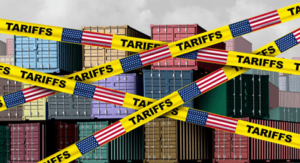
China's Debt Trap Diplomacy
China’s debt trap diplomacy, a term coined to elucidate the strategic aspects of the ‘One Belt, One Road’ (OBOR) Initiative, has become a focal point in contemporary geopolitics. This initiative, aimed at fostering global connectivity through infrastructure projects, reveals a complex geopolitical game.
As China extends financial support to nations for infrastructure development, concerns arise about the hidden consequences and potential debt entrapment. This introduction seeks to unravel the intricacies of China’s debt trap diplomacy, shedding light on the geopolitical maneuvers embedded within the OBOR Initiative and the implications it holds for participating nations.
Table of Contents
China’s Debt Trap Diplomacy
China’s ambitious ‘One Belt, One Road’ (OBOR) initiative, launched in 2013, has been a subject of both awe and skepticism. While it promises to create a vast network of infrastructure connecting Asia, Europe, and Africa, concerns have been raised about the hidden agenda of what has been dubbed as “China’s debt trap diplomacy.”
This article aims to delve into the multifaceted aspects of China’s debt trap diplomacy associated with the OBOR initiative, exploring its geopolitical implications, impact on recipient nations, and the global response to this strategic move.
1. The Mechanics of Debt Trap Diplomacy
China’s debt trap diplomacy involves extending loans to developing nations for infrastructure projects under the OBOR initiative. However, the terms of these loans often raise eyebrows. Reports suggest that the interest rates on these loans are not always favorable, and the conditions for repayment may put a considerable strain on the borrowing nations. This creates a situation where countries find themselves increasingly indebted to China, paving the way for Beijing to exert influence over their domestic and foreign policies.
According to the Center for Global Development, several OBOR participating countries, including Pakistan, Sri Lanka, and Djibouti, have found themselves grappling with unsustainable debt burdens. Sri Lanka’s Hambantota port, for instance, was handed over to China on a 99-year lease in 2017 as part of a debt-for-equity swap. This example raises concerns about the long-term sovereignty of nations falling into the debt trap laid out by China.
2. The Geopolitical Chessboard
China’s debt trap diplomacy is not merely an economic strategy; it is deeply intertwined with geopolitical maneuvering. The strategic locations of infrastructure projects funded by China, such as ports and railways, have significant geopolitical implications. The development of Gwadar port in Pakistan, funded by China, is a case in point. Situated at the crossroads of the Middle East, South Asia, and Central Asia, Gwadar provides China with a crucial maritime foothold and serves as a potential military outpost.
The geopolitical chessboard becomes more evident when considering the broader network of infrastructure projects under the OBOR initiative. As China expands its influence through economic ties, it gains strategic leverage, enabling it to shape the geopolitical landscape in its favor. This calculated approach to global influence has sparked concerns among other major powers, prompting a reevaluation of their own geopolitical strategies in response to China’s rising influence.
3. Recipient Nations: Economic Development vs. Dependency
While the OBOR initiative offers recipient nations the prospect of much-needed infrastructure development, the long-term consequences of debt trap diplomacy raise questions about economic sustainability and national autonomy. Many of the countries involved in the OBOR initiative are developing nations with fragile economies and limited fiscal capacities.
As these nations accumulate debt to fund infrastructure projects, they risk falling into a cycle of economic dependency on China. The repayment terms of loans often require significant portions of the recipient countries’ GDP, diverting resources from crucial social services and development programs. This dilemma has led to growing discontent among local populations and fueled debates about the true cost of China’s assistance.
4. Global Concerns and Responses
China’s debt trap diplomacy has not gone unnoticed on the global stage. Concerns about the geopolitical and economic implications of the OBOR initiative have prompted international organizations and major powers to reassess their relationships with China. Some countries have raised questions about the lack of transparency in loan agreements and the potential environmental and social impacts of Chinese-funded projects.
The United States, in particular, has expressed skepticism about the OBOR initiative, viewing it as a tool for expanding China’s influence and challenging the existing global order. In response, the U.S. has sought to counterbalance China’s economic and geopolitical influence by enhancing its own engagement in the Indo-Pacific region and offering alternative financing options to OBOR participating countries.
5. The Way Forward: Balancing Development and Sovereignty
As countries navigate the complex web of China’s debt trap diplomacy, finding a balance between economic development and safeguarding national sovereignty becomes paramount. Transparency in loan agreements, responsible lending practices, and careful evaluation of the long-term consequences are essential steps in mitigating the risks associated with the OBOR initiative.
Recipient nations must exercise caution in negotiating loan terms, ensuring that infrastructure development projects contribute to sustainable economic growth without compromising their ability to make sovereign decisions. Additionally, the international community, including multilateral organizations and major powers, should work collaboratively to establish guidelines for responsible lending practices and foster a transparent and inclusive approach to infrastructure development.
6. Case Studies: Sri Lanka and Pakistan
China’s extensive investments in infrastructure projects across developing nations, financed through loans and promises of easy credit, have led to financial troubles for several completed endeavors. The Mattala Rajapaksa International Airport in Sri Lanka, opened in 2013, is considered the world’s emptiest airport.
Similarly, the Magampura Mahinda Rajapaksa Port in Hambantota and Pakistan’s Gwadar port are largely underutilized. Despite project failures, China benefits from increased leverage over indebted nations, using its clout to influence geopolitical dynamics.
China’s strategic objectives involve commercial penetration and securing geopolitical influence. Some indebted countries are compelled to cede stakes or grant majority ownership in Chinese-financed projects. Allegations of Chinese bribery and corruption have prompted investigations in countries like Sri Lanka and Nigeria.
In Sri Lanka, former President Mahinda Rajapaksa’s nine-year rule saw significant Chinese investments. However, when President Maithripala Sirisena came to power in 2015, he aimed to extricate Sri Lanka from the Chinese debt trap, suspending major projects. Despite these efforts, Sri Lanka faced default, forcing a return to Chinese support. Sirisena’s decision to sell an 80% stake in the Hambantota port to China for $1.1 billion sparked accusations of undue concessions.
China’s integrated approach, combining foreign, economic, and security policies, allows it to establish a hegemonic sphere. As countries grapple with onerous debt, China’s neocolonial designs advance. The situation serves as a cautionary tale for nations yet to be ensnared in China’s debt trap, urging them to take preventive measures to avoid similar entanglements.
Bottom Line
China’s debt trap diplomacy through the OBOR initiative is a complex geopolitical game with far-reaching implications. Though India-Middle East-Europe Economic Corridor is trying to be established by western countries and India. While the initiative holds the promise of transformative infrastructure development, the potential risks of economic dependency and loss of national sovereignty cannot be ignored.
The global community must remain vigilant, advocating for responsible lending practices and supporting recipient nations in navigating the intricate dynamics of China’s strategic game.





